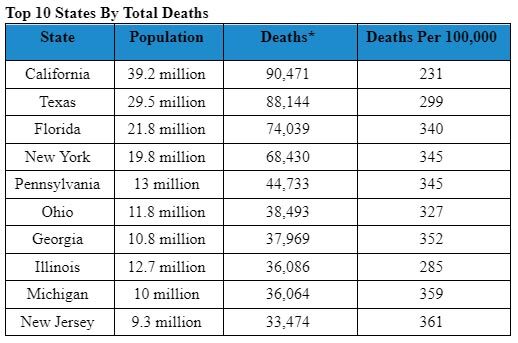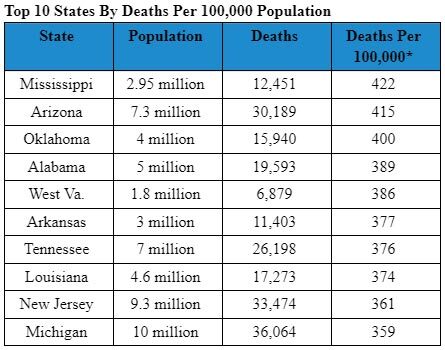By Doug Donovan / Johns Hopkins University Coronavirus Resources Center.
The United States officially surpassed one million reported COVID-19 deaths today, according to data from the Johns Hopkins Coronavirus Resource Center.
It’s a morbid milestone for a virus that first emerged in China in late 2019, claimed its first American lives in early 2020, and rapidly became the third leading cause of U.S. deaths.
The number of fatalities is likely much higher both in the United States and around the world, experts said. Globally, approximately 6.3 million people have died of COVID-19, although a recent World Health Organization review has estimated the total could be more than two times higher – including 110,000 more deaths in the United States than were documented last year.
“The United States has reached the once unthinkable grim milestone of one million COVID-19 deaths,” said William Moss, CRC vaccinology lead and executive director of the Johns Hopkins International Vaccine Access Center. “Equally tragic, and also once unthinkable, are the recent WHO estimates that the pandemic resulted in nearly 15 million excess deaths globally in 2020 and 2021.”
Most experts say a million people in the U.S. died from the disease weeks or months ago. President Biden marked what he called the “tragic milestone” on May 12 by ordering all flags flown at half-staff and demanding that citizens “remain vigilant against this pandemic” that has infected nearly 60% of the U.S. population.
“While one million COVID-19 deaths is a mind-boggling number, we know that the U.S. actually reached this tragic milestone some time ago,” said Crystal Watson, the CRC’s public health lead and a senior scholar at the Johns Hopkins Center for Health Security. “Hundreds of thousands more people have died from COVID-19 in the U.S. than are officially counted.”
Watson said the “public health impact of such widespread death cannot be captured in these numbers alone.”
“While one million COVID-19 deaths is a mind-boggling number, we know that the U.S. actually reached this tragic milestone some time ago.”
“People who die from COVID-19 leave behind family and friends, children without parents and grandparents to care for them, spouses and partners, and in some cases parents who must go on without their children,” she added. “The shock of so many deaths, along with the large number of people now living with long-COVID symptoms, means that this pandemic will unfortunately be felt by individuals, and reflected in our public health data, for a long time to come.”
Beth Blauer, CRC data lead and associate vice provost for Public Sector Innovation, said the death toll’s tragedy is compounded by the realization that far more have perished.
“Our data reporting and tracking systems are so flawed that local, state, and federal agencies have not been able to convey with full confidence just how deadly this pandemic has been,” Blauer said. “What’s worse, the nation has essentially ceased tracking testing results in any way that would be meaningful for equipping the public and policy makers with the best data for making smart decisions on how to proceed with daily life.”
She cautioned that “the pandemic is not over” regardless of the lifting of mask mandates and other precautions and the reduction in data collection.
“People continue to die every day of COVID-19, some needlessly so,” Blauer added. “Infections continue to spread, but where and how widely becomes a deeper mystery every day the government fails to implement a national strategy for capturing all available testing data, including results from at-home tests.”
Reported COVID-19 deaths in the United States increased nearly 36% from around 350,000 in 2020 to nearly 475,000 in 2021, according to an analysis of CRC data by Emily Pond, a CRC research data analyst. The rate of increase has slowed this year by 23%, from 222,000 deaths recorded in the first four months of 2021 to 170,000 fatalities over the same period in 2022.
But the Omicron variant in late 2021 fueled a recent spike that drove the number of U.S. deaths over the past six months – from November 2021 through April 2022 – to nearly 250,000. That represented a 45% increase over the previous six months from May 1 to Oct. 31, 2021, according to Pond’s analysis.
“About 60% of all adult COVID-19 deaths in the United States since June 2021 could have been prevented through vaccination, an estimated 234,000 deaths”
Data from the Centers for Disease Control and Prevention indicated that the emergence of COVID-19 as the third leading cause of U.S. deaths after heart disease and cancer in 2020 and 2021 also served to lower life expectancy in both years.
Dr. Brian Garibaldi, CRC clinical lead and medical director of the Johns Hopkins Biocontainment Unit, said the impact of deaths on hospitals and health care staff has shifted throughout the pandemic.
“In the spring of 2020 nearly half of the deaths we saw in the hospital were in nursing home residents who had severe underlying co-morbidities,” Garibaldi said. “By the time the Delta variant arrived most of the ICU admissions and deaths were occurring in unvaccinated individuals.”
COVID-19 patients faced a “substantial risk of dying” once they began to suffer from “severe respiratory disease requiring mechanical ventilation,” he said.
“More recently, we have been seeing severe cases among individuals with underlying immune system problems who are unable to mount an effective response to the vaccines,” Garibaldi added. “Vaccines and boosters dramatically reduce the risk of developing severe disease and have really changed the game by reducing the number of patients who require ICU-level care.”
“We cannot afford to become numb to these numbers.”
Moss said many deaths in the United States and around the world could have been averted if more people had received vaccines. Just two-thirds of the total U.S. population has been fully vaccinated, according to CRC data. And 40% of the global population, approximately 3 billion people, remains unvaccinated.
Although vaccines could not have prevented the deaths of the nation’s most vulnerable citizens – elderly and immunocompromised individuals – a substantial number of lives would have been saved “had we achieved higher vaccination rates more quickly,” Moss said.
“A recent analysis by the Kaiser Family Foundation estimated that 60% of all adult COVID-19 deaths in the United States since June 2021 could have been prevented through vaccination with just the primary series alone, an estimated 234,000 deaths,” Moss said. “We must continue to strive to achieve higher vaccination coverage with COVID-19 vaccines both here in the United States and globally to avert an even greater disaster. We cannot afford to become numb to these numbers.”
The deadliest month for the pandemic in the United States was January 2021 when nearly 98,000 people perished – about 3,200 daily, Pond’s analysis shows. The CRC recorded just under 13,000 deaths in April 2022, about 425 per day.
Not surprisingly the nation’s three largest states – California, Texas, and Florida – recorded the most raw number of deaths, according to CRC data. On a per capita basis, Mississippi, Arizona, and Oklahoma experienced the most deaths per 100,000 residents while Hawaii, Vermont, and Puerto Rico reported the lowest number per capita.


